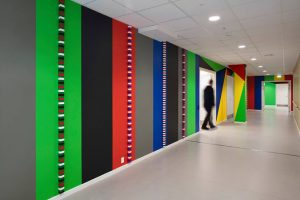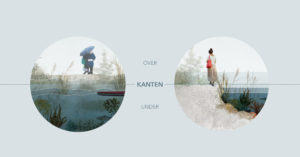This is how art can be included when society restarts
Here are 9 suggestions from the Association of Visual Artists (BKF) on how the visual arts can contribute to the kick-start of society that is necessary in the wake of COVID-19. The plan The art during COVID-19 has been prepared by BKF's board and secretariat, May 2020.

Thorgej Steen Hansen: Decoration, Albertslund Sundhedshus (2019). Photo: Dorte Krogh.
1. Give the citizens art where we walk on a daily basis
Art sharpens our senses, spirit and intellect – art gives us 'the necessary reflection', as Prime Minister Mette Frederiksen expressed it during the Corona crisis. Give more citizens opportunities to encounter the professional visual arts in everyday life by establishing a special COVID-19 pool for municipalities and private business, which co-finances e.g. 50 percent of the budgets and thus creates an incentive for starting new art projects. Eg. in schools, daycare centers, nursing homes, libraries, cultural centers, sports facilities and other municipal buildings as well as public digital platforms. And in companies, shops, shopping centers and generally in the liberal professions.
2. Consider art in the renovation of public housing
To keep a hand on the construction industry and secure the Danish economy, the government will spend DKK 30 billion. DKK to renovate the country's public housing from 2021-2026. Here, art can advantageously be considered from the start of the processes, so that the renovation creates the greatest possible value for the residents. Because quality in construction is not only about bricks and insulation material, it is also about aesthetics, sensuality and communities. Set aside e.g. 0,5 percent of the funds for the Landsbyggefonden's renovation projects for artistic decoration and art projects that can create everyday joy and increased cohesion in residential areas. Even small sums of money for art have a big effect, as shown by many of the successful projects that artists have implemented in residential areas throughout the country in recent years.
3. Consider the arts in the advanced projects of municipalities and regions
The regions and municipalities have been released from the so-called construction ceiling this year to support Danish business during the Corona crisis. This means advanced construction and plant investments of up to DKK XNUMX billion. Set aside an amount for art in the budgets and include art in all the new roads, schools and sports facilities that are now to be built - so that the construction projects give citizens the most value and quality in everyday life.

Dawn Directions. International young graphics curated by visual artist Rasmus Danø at the Copenhagen gallery Format Artspace 2019.
4. Strengthen the desire to buy contemporary art
During the quarantine, many discovered how much they missed art. Give more people the opportunity to have contemporary art in their living rooms – even those who do not necessarily have large sums of money available for art purchases. Introduce a tax deduction of DKK 20.000 annually for the first purchase of works of art by living artists.
5. More contemporary art for everyone
The citizens love art - this is evidenced both by user surveys and the number of visitors to the museums over the past several years. Create more opportunities for all citizens to encounter contemporary art by increasing the purchasing budget in the Statens Kunstfond. Then even more works than now can be loaned to public buildings and meet citizens in everyday life. Furthermore, establish a special COVID-19 pool for the art museums' purchase of contemporary art created by local visual artists. It can form the basis for new, current and relevant exhibitions and at the same time support the domestic art scene.
6. The art out into more public spaces
Why should e.g. motorways, tunnels and bridges be gray and boring experiences? And why can't public digital platforms offer users an aesthetic and thought-provoking art experience? Create more artistic experiences in both physical and digital public spaces by reorganizing the state art circular. And make the circular more flexible, so that the funds for art can be used where they create the most value for citizens. Set aside 0,5% of the construction cost of all public construction projects for artistic decoration and create more quality in all the public spaces we share and move in every day.

An incentive should be created for the artists to think along with the green transition. Vejle Municipality is already underway. Here, artists are involved in the design of the city's climate protection, i.a. in the idea competition 'Kanten'.
7. Consider art in the green transition
The transition to green infrastructure, sustainable energy and new habits in everyday life requires that we include art and culture. Visual artists can contribute with hitherto overlooked angles, create interdisciplinary collaborations and facilitate inclusive processes that increase the durability and quality of the green projects in citizens' everyday lives.
8. Strengthen the working conditions of young artists
The corona crisis makes it even more difficult for young artists to gain a foothold in the industry. We risk losing artistic talent on the floor, which could put Danish art on the world map in the future. Give newly qualified artists better access to the professional art life by creating an Artist's Assistant scheme based on the Norwegian model. The arrangement is that a newly qualified artist is assigned to an experienced artist in an internship course of 6-12 months.
9. Pay the artists for displaying the art
The authors get library money, the musicians get KODA money, but visual artists get no payment for displaying works of art in public spaces. On the other hand, visual artists in Sweden do. Introduce a similar system at home. The corona crisis has pulled the rug away from under the visual artists' already small and uncertain incomes, the introduction of reasonable payment to the artists, i.a. in the form of Screening money, is long needed and could remedy some of the financial loss the artists are experiencing at this time.
Top: At Bakkeskolen in Esbjerg, art has been incorporated into a renovation of a 600 square meter linoleum floor. Astrid Marie Christiansen's graphic work now runs across the floor and creates joy in everyday life for students and teachers. In BKF's COVID-19 plan for the arts, politicians are encouraged to create opportunities to include art in far more renovation and construction projects. The art floor is part of the project 6705 + The Norwegian Arts Foundation, a collaboration between the art foundation, Esbjerg Municipality and local institutions. Photo: Anne Trap Lind.